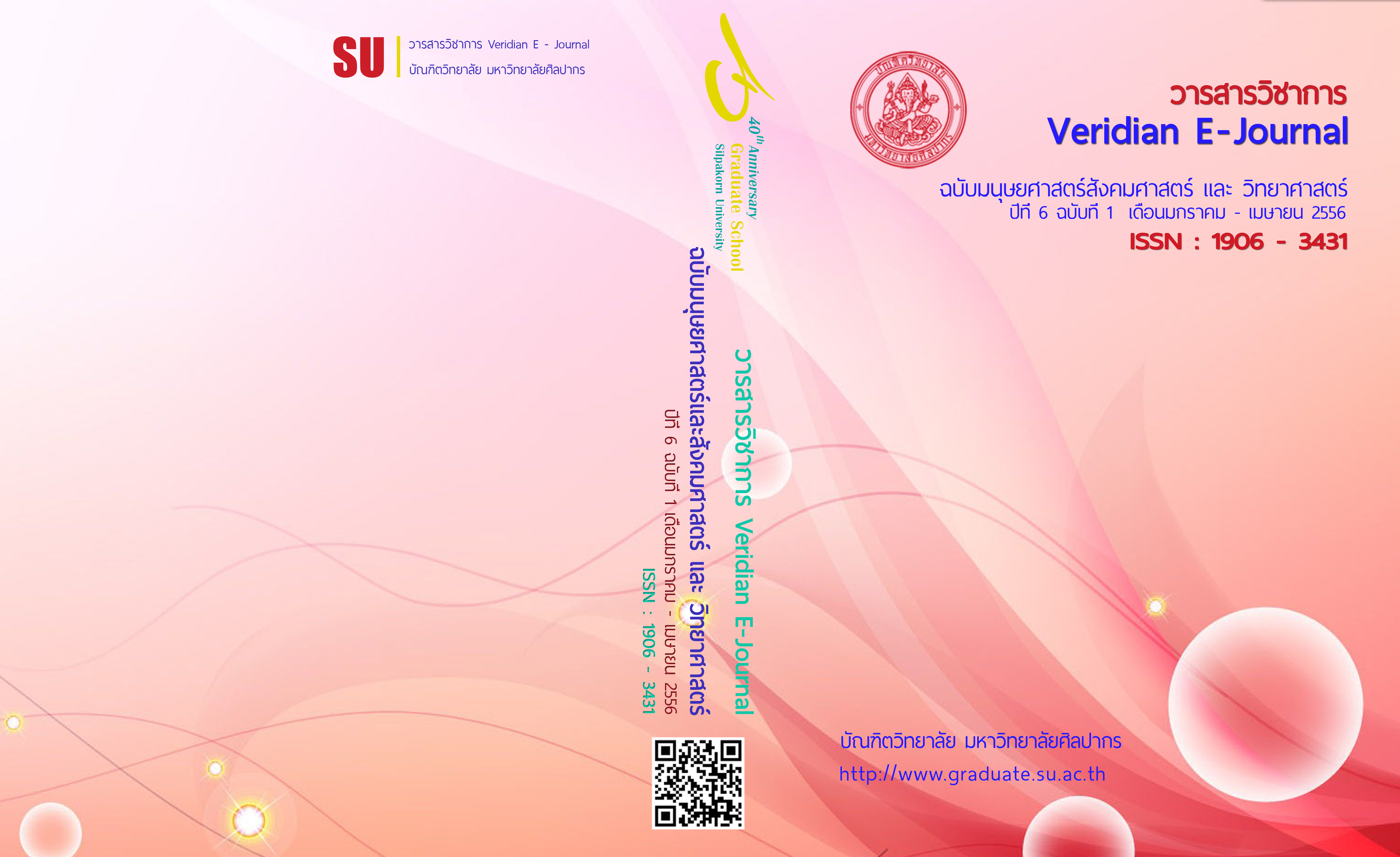การพัฒนาบทเรียนคอมพิวเตอร์ช่วยสอน เรื่องการใช้โสตทัศนูปกรณ์ สำหรับนักศึกษาที่มีความบกพร่องทางการได้ยิน วิทยาลัยราชสุดา มหาวิทยาลัยมหิดล
Main Article Content
บทคัดย่อ
บทคัดย่อ
การวิจัยครั้งนี้มีวัตถุประสงค์ 1) พัฒนาและหาประสิทธิภาพของบทเรียนคอมพิวเตอร์ช่วยสอน เรื่องการใช้โสตทัศนูปกรณ์ 80/80 2) เปรียบเทียบผลสัมฤทธิ์ทางการเรียนก่อนและหลังเรียนด้วยบทเรียนคอมพิวเตอร์ช่วยสอน เรื่อง การใช้โสตทัศนูปกรณ์ 3) เพื่อการศึกษาความพึงพอใจของผู้เรียนที่มีต่อบทเรียนคอมพิวเตอร์ช่วยสอน เรื่อง การใช้โสตทัศนูปกรณ์กลุ่มตัวอย่างที่ใช้ในการวิจัย คือ นักศึกษาที่มีความบกพร่องทางการได้ยินชั้นปีที่ 2 ภาคเรียนที่ 1 ปีการศึกษา 2555 วิทยาลัยราชสุดา มหาวิทยาลัยมหิดล จำนวน 30 คน โดยการสุ่มตัวอย่างอย่างง่าย (Simple Random Sampling) เครื่องมือที่ใช้ในการวิจัยครั้งนี้ ประกอบด้วย 1) แบบสัมภาษณ์แบบมีโครงสร้างเพื่อใช้สัมภาษณ์ผู้เชี่ยวชาญ 2) บทเรียนคอมพิวเตอร์ช่วยสอน เรื่องการใช้โสตทัศนูปกรณ์ สำหรับนักศึกษาที่มีความบกพร่องทางการได้ยิน 3) แบบทดสอบวัดผลฤทธิ์ทางการเรียนเรื่อง การใช้โสตทัศนูปกรณ์ 4) แบบทดสอบความพึงพอใจของผู้เรียนที่มีต่อบทเรียนคอมพิวเตอร์ช่วยสอน การวิเคราะห์ข้อมูลใช้ ค่าเฉลี่ย (X) ส่วนเบี่ยงเบนมาตรฐาน (S.D.) และการทดสอบค่า (t-test) for Dependent Group
ผลการวิจัยพบว่า 1) บทเรียนคอมพิวเตอร์ช่วยสอน เรื่องการใช้โสตทัศนูปกรณ์ สำหรับนักศึกษาที่ มีความบกพร่องทางการได้ยิน วิทยาลัยราชสุดา มหาวิทยาลัยมหิดล มีประสิทธิภาพ 80.00 / 87.44 และเป็นไปตามเกณฑ์ 80 / 80 ที่กำหนดไว้ 2) ผลสัมฤทธิ์ทางการเรียนของนักศึกษาที่เรียนด้วย บทเรียนคอมพิวเตอร์ช่วยสอน เรื่องการใช้โสตทัศนูปกรณ์ สำหรับนักศึกษาที่มีความบกพร่องทางการได้ยิน วิทยาลัยราชสุดา มหาวิทยาลัยมหิดล หลังเรียนสูงกว่าก่อนเรียนอย่างมีนัยสำคัญทางสถิติที่ระดับ 0.05 โดยค่าสถิติ t – test ที่ได้มีค่าเท่ากับ 4.18 3) ความพึงพอใจของนักศึกษาที่มีต่อบทเรียนคอมพิวเตอร์ช่วยสอน เรื่องการใช้โสตทัศนูปกรณ์ สำหรับนักศึกษาที่มีความบกพร่องทางการได้ยิน วิทยาลัยราชสุดา มหาวิทยาลัยมหิดลอยู่ในระดับ มาก เป็นไปตามสมมติฐานที่ตั้งไว้ มีค่าเฉลี่ยความพึงพอใจโดยภาพรวมเท่ากับ 4.36 (X = 4.36, S.D.= 7.96)
Abstract
The purposes of this study were 1) to develop and determine the effectiveness of computer-assisted instruction on the use of audio-visual 2) to compare student achievement before and after the study with a computer-assisted instruction on the use of visual aids 3) to study the satisfaction of the students with hearing impairment using computer-assisted instruction on visual aids. The sample used in the study were the second year students with hearing impairment, first semester of academic year 2555, Ratchasuda College, Mahidol University. The sample of this research was 30 students with hearing impairment by simple random sampling.
The instruments of this research were 1) the interview with structure to interview the experts 2) CAI, the use of visual aids for students with hearing impairment 3) the learning achievement test 4) the satisfaction test to the CAI. The statistics in data analysis were mean (X), standard deviation (S.D.) and t-test for dependent group.
Analysis results were concluded as follow : 1) The result of the computer-assisted instruction was 80.00 / 87.44 which is higher than the 80/80 2) The posttest scores of scores a significant difference at .05 than that of the petest score. (t-test = 4.18) 3) Students satisfaction on cai was rated as high (X = 4.36, S.D. = 7.96).

